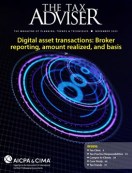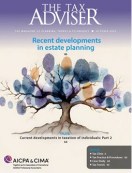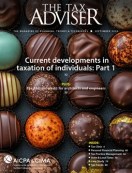- tax clinic
- credits against tax
Determining qualified rehabilitation expenditures
Please note: This item is from our archives and was published in 2021. It is provided for historical reference. The content may be out of date and links may no longer function.
Related
IRS clarifies health savings account changes in H.R. 1 in new notice
Notice 2025-27 provides interim guidance on corporate AMT
IRS approves medical deduction for IVF, denies it for surrogacy
Editor: Lori Anne Johnston, CPA, J.D.
According to the fiscal 2019 National Park Service (NPS) annual report for the Federal Historic Preservation Tax Incentives Program (Federal Tax Incentives for Rehabilitating Historic Buildings, available at www.nps.gov), 45,383 historic projects have been certified with an estimated $102.64 billion of investment since 1977, with over $5.77 billion in private investment in 2019 alone. As of this most recent report, 37 states also offer a state historic tax credit. These rehabilitation projects have included various structures, such as apartment buildings, sports complexes, and even a sheep ranch.
Prior to 2018, qualified rehabilitation expenditures (QREs) made with respect to a qualified but not certified historic building were eligible for a 10% credit if the building was originally placed in service by Dec. 31, 1935. In December 2017, the law known as the Tax Cuts and Jobs Act, P.L. 115-97, repealed that 10% tax credit. Certified historic buildings continue to qualify for a credit equal to 20% of QREs, but now the credit must be claimed ratably over a five-year period (Sec. 47(a)(1) and Regs. Sec. 1.47-7).
Despite the diversity in development, all projects must meet the four basic requirements of a qualified rehabilitated building in Sec. 47(c)(1)(A):
- There must be a substantial rehabilitation. Sec. 47(c)(1)(B) states that the QREs must exceed the greater of the adjusted basis of the building or $5,000.
- The building must be placed in service prior to the rehabilitation.
- The building must be a certified historic structure. Per Sec. 47(c)(3), the building must either be listed in the National Register of Historic Places or located in a historic district and certified by the secretary of the Interior as being of historical significance to the district. If the historic structure is not listed on the National Register, the owner must file an application, NPS Form 10-168, Historic Preservation Certification Application, “Part 1 — Evaluation of Significance,” with the NPS. This application must first be approved by the applicable state historic preservation office (SHPO) and then approved by the NPS. Project owners must also complete “Part 2 — Description of Rehabilitation” and “Part 3 — Request for Certification of Completed Work.” Both these forms must also be approved by the SHPO, and although not expressly required, the NPS highly recommends submitting Part 2 prior to commencing construction to avoid incurring nonapproved expenditures.
- The building must be depreciable, thus eliminating noncommercial historic structures.
To calculate the historic tax credit and determine whether the rehabilitation project passes the substantial-rehabilitation test, QREs are analyzed after the project’s completion. To qualify as a QRE, the expenditure must meet the requirements of Regs. Sec. 1.48-12(c):
- Property must be chargeable to the capital account. Regs. Sec. 1.48-12(c)(2) further explains that expenditures must be capitalized and should not be expensed when incurred.
- Expenditures must be incurred by the taxpayer. Irrespective of the taxpayer’s method of accounting, the expenditures follow the accrual method for purposes of this section. A taxpayer may treat acquired QREs as incurred if the building was not previously used (personal or business use) and the credits are claimed by only the acquiring taxpayer (Regs. Sec. 1.48-12(c)(3)(ii)(A)).
- The property must be real property and depreciable under Sec. 168. The regulations further define depreciable real property as nonresidential or residential real property, real property with a class life of more than 12.5 years, or “an addition or improvement” to such property (Regs. Sec. 1.48-12(c)(4)(i)).
- The expenditures must be in conjunction with the rehabilitation of a qualified rehabilitated building (Regs. Sec. 1.48-12(c)(5)).
Expenditures expressly ineligible as QREs are listed in Regs. Sec. 1.48-12(c)(7) and include, but are not limited to, building enlargements, a noncertified rehabilitation, lessee expenditures with a recovery period under Sec. 168(c) greater than the remaining lease term, tax-exempt-use property, and acquisition costs. Interest related to an acquisition loan is not a qualifying cost; however, interest related to loan proceeds used for QREs may qualify (Regs. Sec. 1.48-12(c)(9)).
Additional complexities arise when evaluating each expenditure. For example, carpet can be either personal property or a structural component, depending upon installation. Regs. Sec. 1.48-1(e)(2) states that flooring intended to be permanent is a structural component; however, the IRS determined that wall-to-wall carpeting hooked to wooden strips on a floor was not a permanent floor covering and therefore was personal property (Rev. Rul. 67-349).
Once QREs are determined and placed in service, the project must meet the requirements of the substantial-rehabilitation test. For a nonphased project, the substantial-rehabilitation period is 24 months (Sec. 47(c)(1)(B)(i)); however, a phased project may use a 60-month rehabilitation period (Sec. 47(c)(1)(B)(ii)). This 24-month or 60-month period is referred to as the measuring period. The measuring period begins on the first day of either the 24-month or 60-month period selected by the taxpayer and ends on the last day of the tax year containing that period. When calculating the rehabilitation tax credit, the taxpayer may include qualifying expenditures related to the rehabilitation incurred prior to the measuring period, during the measuring period, and through the end of the tax year in which the measuring period ends (Regs. Sec. 1.48-12(c)(6)).
As restated in Regs. Sec. 1.47-7(c) and detailed in Regs. Sec. 1.168(k)-2(g)(9)(i)(B), the eligible basis of the QREs must be reduced by additional first-year depreciation. Although the requirements of the QREs eliminate bonus-eligible personal property, the taxpayer must evaluate qualified improvement property (QIP). Some taxpayers may find the benefits of additional first-year depreciation for QIP outweigh the benefits of the tax credit. If the tax credit is deemed more beneficial, to take the credit the taxpayer must elect out of bonus depreciation under Sec. 168(k)(7) for a specific class of property. If the taxpayer chooses to elect out of bonus depreciation for QIP, the taxpayer is unable to use additional first-year depreciation on any QIP, even if the expenditure for the QIP does not qualify as a QRE.
EditorNotes
Lori Anne Johnston, CPA, J.D., is a manager, Washington National Tax for RSM US LLP.
For additional information about these items, contact the author at Laura.Turner@rsmus.com.
Contributors are members of or associated with RSM US LLP.














